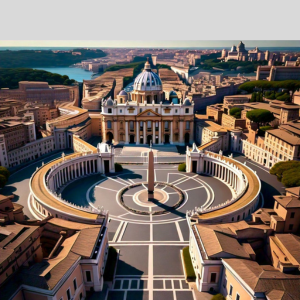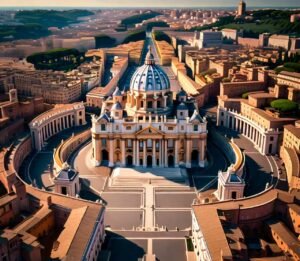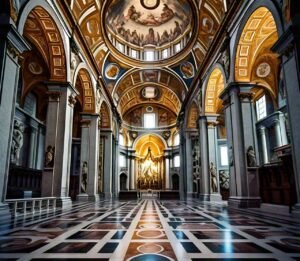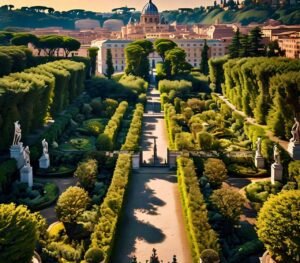Table of Contents
ToggleVatican City Pilgrimage: Faith, History & Artistic Wonder

Vatican City, the smallest independent state in the world, holds immense cultural and religious significance. This tiny sovereign state, nestled within the heart of Rome, Italy, holds immense significance for the Catholic faith and boasts a treasure trove of artistic and historical marvels. Let’s embark on a virtual journey to explore the Vatican City pilgrimage, its sacred sites, historical landmarks, and spiritual highlights that make Vatican City a must-visit destination for pilgrims.
History and Significance of Vatican City
Brief History
Vatican City, the smallest independent state in the world, has a rich history that dates back to the early days of Christianity. It was established as an independent city-state in 1929 with the signing of the Lateran Treaty between the Holy See and Italy. However, its significance as a religious center stretches back centuries, with St. Peter’s Basilica standing on the site believed to be the burial place of Saint Peter, one of Jesus’ apostles and the first Pope.
The Vatican City’s Religious Significance
The Vatican City functions as the spiritual and administrative center of the Roman Catholic Church. It is the residence of the Pope, the leader of the worldwide Catholic community, and the site of many important religious events, including papal conclaves, masses, and ceremonies. The city is also home to numerous sacred relics, artworks, and historical documents that are central to the Catholic faith.

Why is the Vatican City Famous?
Center of the Roman Catholic Church
Vatican City’s fame stems from its role as the heart of the Roman Catholic Church. As the spiritual headquarters, it attracts millions of pilgrims and tourists each year who seek to deepen their faith, experience the grandeur of its sacred spaces, and witness the leadership of the Pope.
Home to the Pope
The Pope, the Bishop of Rome, resides in Vatican City, making it a place of immense significance for Catholics. The Pope’s addresses, blessings, and public appearances draw large crowds, and his residence underscores the city’s central role in the spiritual lives of millions.
Understanding the Holy See
The Holy See refers to the jurisdiction of the Bishop of Rome, encompassing the central governing body of the Catholic Church. It operates independently of Vatican City State, exercising authority over the global Catholic Church and maintaining diplomatic relations with countries around the world.
While Vatican City is the physical territory, the Holy See represents the spiritual and administrative authority of the Pope and the Catholic Church. This distinction is important for understanding the dual aspects of Vatican City’s influence: its role as a sovereign state and its religious governance.
Preparing for the Pilgrimage
Essential Tips for Travelers
Planning a pilgrimage to Vatican City requires careful preparation. Ensure you have all necessary travel documents, including a valid passport and any required visas. Dress modestly when visiting religious sites, and be prepared for security checks.
Best Times to Visit the Vatican City
The best times to visit Vatican City are during the spring (April to June) and fall (September to October) when the weather is mild and the crowds are smaller. Avoid the peak summer months if possible, as the city can be very crowded and hot.
Sacred Places to Visit in the Vatican City
- Peter’s Basilica: The crown jewel of the Vatican City, St. Peter’s Basilica is the largest church in the world. Designed by renowned architects, including Michelangelo, it stands on the site where Saint Peter was martyred and buried. Inside, you’ll find stunning works of art, including Michelangelo’s Pietà and the magnificent Bernini’s Baldachin, a bronze canopy over the main altar. The awe-inspiring dome is also designed by him. A visit inside St. Peter’s Basilica is a journey through history and art. Key sites include the Chapel of the Sacrament, the tomb of Saint Peter, and the many chapels dedicated to various saints. The interior is adorned with mosaics, marble sculptures, and stunning architectural details.
- St. Peter’s Square : Designed by Gian Lorenzo Bernini, St. Peter’s Square is a grand open space that can accommodate thousands of pilgrims. Its colonnades symbolize the embracing arms of the Church. The square is the site of papal audiences, ceremonies, and blessings, drawing large crowds eager to see and hear the Pope.
- The Necropolis: Beneath St. Peter’s Basilica lies a vast necropolis, believed to be the burial ground of St. Peter himself. This sacred site offers a unique look into early Christian history and the foundations of the Catholic Church.

- The Vatican Museums: The Vatican Museums house one of the world’s most extensive art collections, amassed by the popes over centuries. The museums include the Gallery of Maps, the Raphael Rooms, and the Pio-Clementine Museum. Notable pieces include the Laocoön Group, the Apollo Belvedere, and countless works by Renaissance masters. The museums are also home to the Vatican’s ethnological collection, showcasing artifacts from around the world.
- Sistine Chapel – Michelangelo’s Masterpiece: The Sistine Chapel is renowned for its stunning ceiling painted by Michelangelo, depicting scenes from Genesis, including the iconic Creation of Adam. The Last Judgment, also by Michelangelo, adorns the altar wall. The Sistine Chapel serves as the site of the papal conclave, where new popes are elected. Visitors should respect the sacred atmosphere, maintaining silence and dressing appropriately.
- The Apostolic Palace: The official residence of the Pope, the Apostolic Palace offers glimpses into papal history and houses impressive art collections.
Beyond the Must-Sees:
- The Vatican Gardens: Offering a serene escape from the city’s bustle, the Vatican Gardens are a haven of tranquility. Guided tours are available. Covering nearly half of Vatican City, these gardens are beautifully landscaped with fountains, sculptures, and rare botanical species. Access to the gardens is only possible through guided tours, providing an exclusive glimpse into this serene area.

- The Scavi Tour: Delve deeper into the history beneath St. Peter’s Basilica with this special tour that explores the necropolis and early Christian structures.
- Castel Sant’Angelo: This imposing fortress-turned-museum offers stunning views of Rome and historical exhibits.
Attending a Papal Audience
Tickets to papal audiences are free but must be requested in advance. They can be obtained through the Prefecture of the Papal Household or certain church offices in Rome.
Papal audiences typically include a greeting, a message from the Pope, and a blessing. They provide a special opportunity to see the Pope up close and receive his blessing.
Participating in Religious Services
Schedule of Masses: Masses are held daily at St. Peter’s Basilica, with special services on Sundays and holy days. Check the Vatican’s schedule for exact times and locations.
Special Events and Celebrations: Major liturgical events, such as Christmas and Easter, are celebrated with grandeur and attract large numbers of pilgrims. These events often require tickets, which should be reserved well in advance.
Vatican Library and Archives
The Vatican Library and Archives hold a vast collection of manuscripts, books, and documents. Access is generally restricted to researchers, but certain areas may be open to guided tours.
The library’s treasures include ancient biblical texts, medieval manuscripts, and historical documents that have shaped the history of the Church and the world.
Embarking on Your Own Vatican City Pilgrimage
When planning your pilgrimage, consider the following routes:
- Via Francigena: A historic pilgrimage route from Canterbury to Rome, passing through the Vatican City.
- Camino di Francesco (St. Francis Way): Follow in the footsteps of St. Francis of Assisi.
- Via degli Dei (Way of the Gods): A trail connecting Bologna to Florence.
- Way of St. Benedict: From Norcia to Montecassino.
- Pilgrimage from Assisi: Explore the birthplace of St. Francis.
- Pilgrimage from Loreto: Visit the Holy House of Loreto.
- Pilgrimage from Canterbury: The classic route from England to Rome.
Remember, a Vatican City pilgrimage isn’t just about physical travel; it’s a journey of the soul—a chance to connect with centuries of faith, art, and devotion. So pack your spiritual curiosity and embark on this extraordinary expedition to the heart of Catholicism.
Conclusion
A pilgrimage to Vatican City is a deeply enriching experience, offering a unique blend of spirituality, history, and art. Whether you are attending a papal audience, exploring the Vatican Museums, or simply soaking in the sacred atmosphere, this journey will leave a lasting impact on your soul. Be open to the experience, immerse yourself in the rich history, and allow the sacred atmosphere to touch your heart.
FAQs
- What is the best time of year to visit Vatican City?
The best times to visit are during the spring (April to June) and fall (September to October) for pleasant weather and fewer crowds.
- How can I get tickets to a papal audience?
Tickets are free and can be requested through the Prefecture of the Papal Household or certain church offices in Rome.
- Are there dress codes for visiting religious sites in Vatican City?
Yes, modest dress is required. Shoulders and knees should be covered when entering churches and religious sites.
- Can I take photographs inside the Vatican Museums and St. Peter’s Basilica?
Photography is allowed in most areas of the Vatican Museums and St. Peter’s Basilica, but flash and tripods are typically prohibited.
- Is it possible to visit the Vatican Gardens?
Yes, but access is only available through guided tours, which must be booked in advance.
